2010
About Andrew Cusack
 Writer, web designer, etc.; born in New York; educated in Argentina, Scotland, and South Africa; now based in London.
Writer, web designer, etc.; born in New York; educated in Argentina, Scotland, and South Africa; now based in London. read more
News
Blogs
Reviews & Periodicals
Arts & Design
World
France
Mitteleuropa
Knickerbockers
Argentina
The Levant
Africa
Cape of Good Hope
Netherlands
Scandinavia
Québec
India
Muscovy
Germany
Academica
Cape Town’s Other St. George’s
The Greek Orthodox Cathedral of Saint George
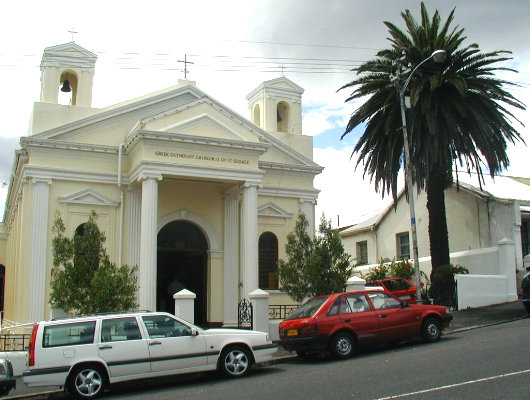
If you hear of “St. George’s Cathedral” in Cape Town, you naturally think of the big stone colossus at the bottom end of the Company’s Garden smack dab in the middle of the Mother City. There is, however, another St. George’s Cathedral, the Greek Orthodox Cathedral of St. George on Mountain Road in Woodstock. The Greek Cathedral was built in 1903–04, just a few years after Cape Town received its first Greek Orthodox priest, and expanded in 1983. Liturgies tend to be either in Greek or English, though there is an Afrikaans monastery at Robertson.
The Holy Archdiocese of the Cape of Good Hope was established in 1968 under the (Greek Orthodox) Patriarch of Alexandria and All Africa. The archdiocese covers the Western, Northern, and Eastern Cape provinces, the Orange Free State, KwaZulu-Natal, Namibia, Lesotho, and Swaziland.
I only ever knew one South African of Greek extraction (Dimitri! Not just a good egg, but a top-notch chef as well), but I assume that folks of Hellenic extraction enjoy the Mediterranean climate of Cape Town and its environs.
Cape Town’s New Way to Get Around

Over at Fascination Street, Brent Smith shows us the newly revealed branding for Cape Town’s new integrated rapid transit system: MyCiti. I’m not partlicularly impressed. Most of my fellow uitlanders will be forgiven for lacking an understanding of the stylised freehand letter ‘y’, which is rather tortured into representing an outline of Devil’s Peak, Tafelberg, and Lion’s Head. Mr. Smith diplomatically reserves judgement but I think they could’ve done better, although they could have done much worse.
Dr. Cornelis Pama
Die grootste Suid-Afrikaanse heraldikus
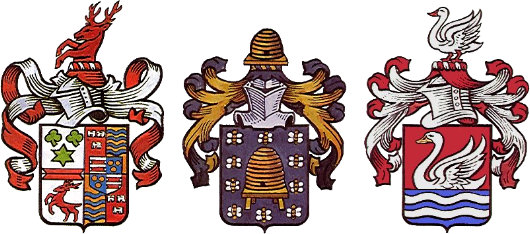
Ferreira — Bezuidenhout — Swanepoel
THE GRANDPAPA OF South African heraldry studies is undoutedly Dr. Cornelis Pama, a heraldist, genealogist, author, and editor of great importance in the field. Pama was one of the original members of the State Heraldry Council when it was founded in 1963 and refined the genealogical numbering system invented by Christoffel Coetzee de Villiers in the nineteenth century and which is now known as the de Villiers/Pama system in recognition of his contribution.
When I resume acquisitioning for my personal library, a whole slew of Pama’s works are on the ‘works sought’ list. Foremost among them is the excellent Lions and virgins: Heraldic state symbols, coats-of-arms, flags, seals and other symbols of authority in South Africa, 1487-1962 which I frequently made use of in the Stellenbosch university library.
Pama also wrote Heraldiek ABC (1980), Heraldiek in Suid-Afrika (1956), Simbole van die Unie (1960), British Families in South Africa: Their Surnames and Origins (1992), The Wine Estates of South Africa (1979), Vintage Cape Town: Historic Houses and Families In and Around the Old Cape (1973), and a history of the South African Library (the Cape Town institution which has since been foolishly merged with the Staatsbiblioteek in Pretoria to form the National Library of South Africa). The S.A.L. received his important private collection of over 800 genealogical and heraldic books and other works after Dr. Pama’s death in 1994. (more…)
A New Scots Town in the Highlands
The 20th Earl of Moray teams up with Miami-based firm Duany Plater-Zyberk to plant a New Town of 10,000 inhabitants outside Inverness
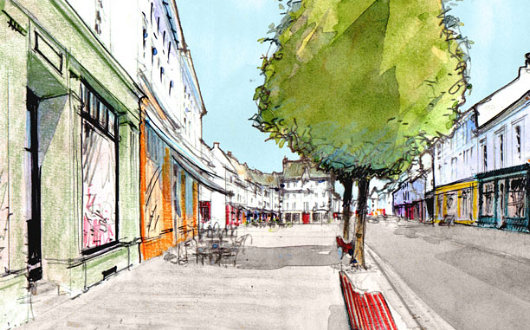
BELEIVE IT OR not, Inverness is one of the fastest-growing cities in Europe, and a local landowner, the 20th Earl of Moray, has teamed up with Duany Plater-Zyberk, an American firm known for its traditional architecture and urbanist ideas, to help create a sustainable new town of 10,000 inhabitants near the “Capital of the Highlands”. Tornagrain will rest on a 200-hectare (500-acre) site on the A96 corridor between Inverness and Nairn. Much of the recent growth in the Highlands has been poorly managed, raising concerns of suburban sprawl and poor land management. Moray Estates, the land holding company of the Earl of Moray (pronounced ‘Murry’) has decided to take the lead by planning a new town in the best tradition of Scottish architecture and urban development. (more…)
The Old New York Observer Building
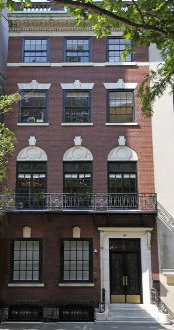
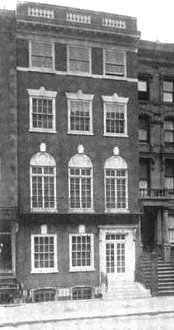
No. 54, East Sixty-fourth Street
“FOR 17 YEARS,” writes Peter W. Kaplan, “since The New York Observer entered city life in 1987, it has existed within a red brick and white-marble-stepped townhouse on East 64th Street.” Designed by Ernest Flagg and Walter B. Chambers during their brief partnership, No. 54 East Sixty-fourth Street (between Park & Madison) was built in 1907 as a private residence for Robert I. Jenks. The AIA guide accurately describes it as “four stories of delicate but unconvincing neo-Federal detail… a minor Flagg.” In 1947, the townhouse was converted into offices for the Near East Foundation, which was founded in 1915 to provide relief for Armenian refugees from the Ottoman Empire and later took on greater responsibilities in North Africa and the Levant. It was then bought by Arthur L. Carter, the founder and publisher of the New York Observer for use as the salmon-tinted newspaper’s headquarters.
In 2004, the Observer moved down to Broadway, two blocks south of the Flatiron Building (and just a few blocks up from The New Criterion whose founder, Hilton Kramer, was for nearly two decades the art critic for the Observer). The townhouse was sold by Carter to the Russian-born Janna Bullock, real estate developer & sometime Guggenheim foundation board member for $9.5 million in the year the newspaper moved out. In 2005, Bullock renovated the building and had it used at the Kips Bay Decorator Show House for the year before selling it on to the Irish investor Derek Quinlan for $18.74 million. Quinlan put it on the market for $36 million but last year the asking price was chopped to $27 million.
Twenty-five feet wide, five stories, and with over 10,000 square feet, No. 54 was probably the only newspaper headquarters to feature nine working fireplaces, rosewood panelling, and oak wainscoting. But the best feature, by a mile, is the splendid iron-railed staircase, which looks like it was lifted straight from Paris. Elegant and graceful, a rare century-old survival in Manhattan. (more…)
Cockerell’s Carlton Club
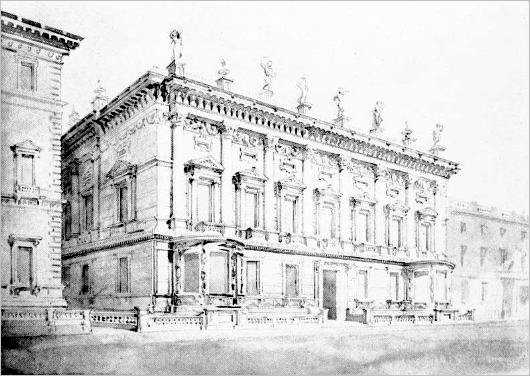
Charles Robert Cockerell is best known for designing both the Ashmolean Museum at Oxford and its Cambridge equivalent, the Fitzwilliam Museum. He is also, alongside William Henry Playfair, responsible for the twelve-columned National Monument that sits atop Calton Hill in Edinburgh — allegedly unfinished, though there is considerable debate over whether this is so. It’s not widely known, however, that the famous architect Cockerell completed a design for a new home for the Carlton Club on Pall Mall in London.
Originally Cockerell had declined the opportunity to submit a design, with such lofty names as Pugin, Wyatt, Barry, and Decimus Burton also declining the offer. A few years later, Cockerell nonetheless worked on this design for the Tory gentlemen’s club, which is superior to that conceived by another architect which was eventually built. Cockerell devised a “lofty Corinthian colonnade of seven bays” according to the Survey of London. “The columns have plain shafts, their capitals are linked by a background frieze of rich festoons, and the Baroque bracketed entablature is surmounted by an open balustrade with solid dies supporting urns and gesticulating statues.” (more…)
A Collector’s Apartment
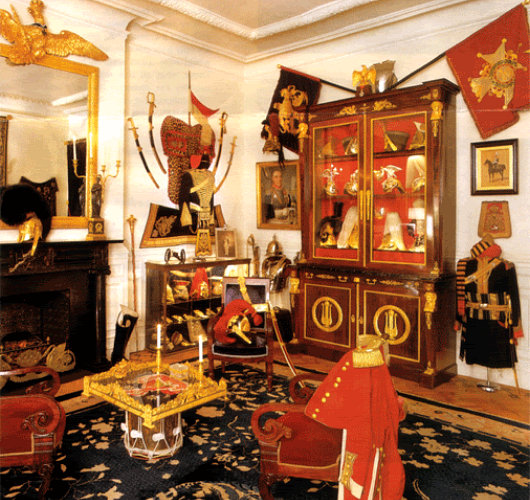
These photos come from an issue of Architectural Digest from the 1980s that some chap scanned and put online. The article that these pictures accompanied was about the New York apartment of a collector specialising in military items, but unfortunately the scanner did not post any further information. (more…)
Curated Secrets
Curated Secrets, the companion blog to our favourite recent book Secret Places, Hidden Sanctuaries, has increased in activity of late. In addition to the report on Freemasonry at Downside that we mentioned before, there has been a rumination on the Third Reich as Gesamtkunstwerk and a post about the attempt to artificially re-Saxonify the English language, which led to such interesting creations of words such as “wheelsaddle” for bicycle and “cellar-thane” for butler. The latest post is on the opium dens of old Singapore, an incongruous concept for those of us whose only conception of the South-east Asian city is as one of the most tightly run and well-managed states in the world.
The Oriental Club
Stratford House, London
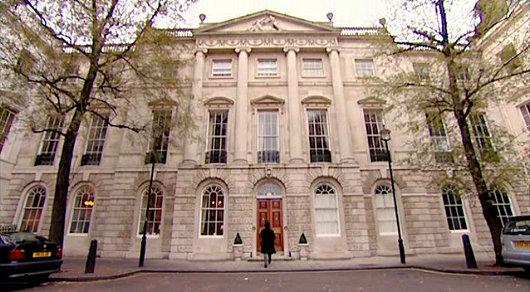
JUST STEPS AWAY  from Oxford Street, one of London’s busiest thoroughfares, rests a quiet little street called Stratford Place probably familiar only to Tanganyikans or Batswana seeking counsel from their countries’ high commissions. At the termination of the dead-end street sit the stately quarters of the Oriental Club: Stratford House. The club was founded in 1824, as British involvement and influence in both India and the Orient was waxing rapidly. General Sir John Malcolm, sometime Ambassador of His Britannic Majesty to the Court of the Peacock Throne (which is to say, Persia), coordinated the founding committee and advertised a club which would draw its members from “noblemen and gentlemen associated with the administration of our Eastern empire, or who have travelled or resided in Asia, at St. Helena, in Egypt, at the Cape of Good Hope, the Mauritius, or at Constantinople.” (more…)
from Oxford Street, one of London’s busiest thoroughfares, rests a quiet little street called Stratford Place probably familiar only to Tanganyikans or Batswana seeking counsel from their countries’ high commissions. At the termination of the dead-end street sit the stately quarters of the Oriental Club: Stratford House. The club was founded in 1824, as British involvement and influence in both India and the Orient was waxing rapidly. General Sir John Malcolm, sometime Ambassador of His Britannic Majesty to the Court of the Peacock Throne (which is to say, Persia), coordinated the founding committee and advertised a club which would draw its members from “noblemen and gentlemen associated with the administration of our Eastern empire, or who have travelled or resided in Asia, at St. Helena, in Egypt, at the Cape of Good Hope, the Mauritius, or at Constantinople.” (more…)
Classical South Africa

I’m rather fond of the little coin logo of the Classical Association of South Africa, which appears on the front page of the society’s scholarly journal, Acta Classica: Verhandelinge van die Klassieke Vereniging van Suid-Afrika.
CASA also publishes, in cooperation with Stellenbosch University, Akroterion: Tydskrif vir die Klassieke in Suid-Afrika.
The study of our ancient civilisation is alive & well in South Africa!
The New Yale Colleges
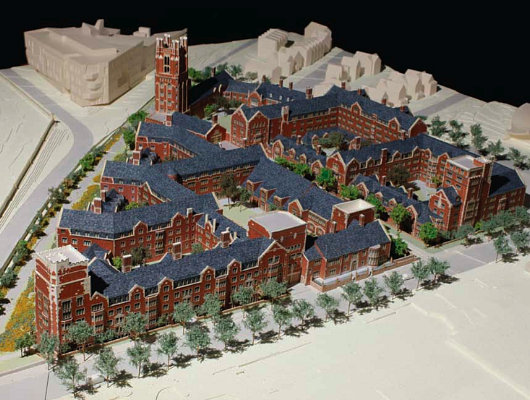
Yale University announced in 2008 that it would erect two new residential colleges in order to expand its undergraduate population without putting further strain on the twelve residential colleges that currently exist. Reportedly, Yale officials took a look at the new Whitman College at Princeton University, designed by traditional architect Demetri Porphyrios and decided even that wasn’t traditional enough. They commissioned Robert A. M. Stern, an architect who has, on occasion, proved exceptionally capable in traditional styles (the American Shingle style in particular), to design the two new colleges at the Connecticut university.
While the new colleges are currently being referred to as ‘North College’ and ‘South College’, there is little doubt that each college will find a generous benefactor who will endow it with funds and in return deign to allow the college to be named after the deep-pocketed soul.
The new colleges will, appropriately, be built in the Collegiate Gothic style, but will be faced in brick instead of stone. Brick facing in Gothic-style buildings always leaves one with a slight dissatisfaction, I’m afraid. Still, the decision to build in a traditional style is of course commendable.
For a commentary on the Collegiate Gothic of today, see this bit from Dino Marcantonio.
Here follow a few of the architect’s renderings of the new colleges. (more…)
Tintin à Quebec
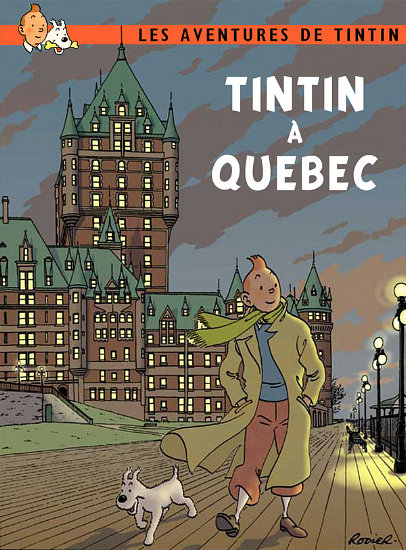
Tintinophilia and its allied science of Tintintology can almost seem like a cult sometime, with Moulinsart, the commercial wing of the Hergé Foundation, acting feverishly to quell any and all unauthorised outbreaks of Tintin resurrection. Their assiduity notwithstanding, Tintin pastiches are fairly common (though illegal) and vary in nature from respectful admiration to downright mockery. The Quebecois cartoonist Yves Rodier is one of the foremost pasticheurs of the famous Belgian boy reporter, and produced this cover (above) of a non-existant Tintin book set in the beautiful capital city of Canada’s French province.
While Tintin did visit Scotland in The Black Isle, I’d love to see a Tintin in Edinburgh book, and even more so Tintin in the Cape.
120 East End Avenue
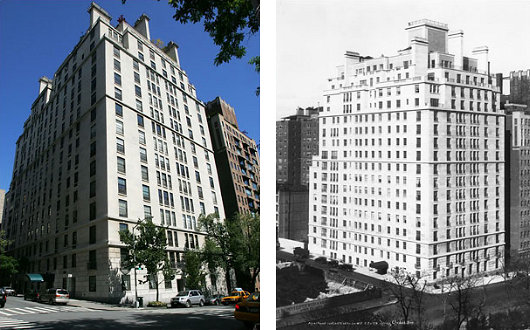
BACK IN MY school days, there was a girl in this building who threw rather good parties. Even at a decent event, however, one or two are bound to show up that really ought not to have done so, and at one of these parties at 120 East End Avenue just such a person got wildly drunk, seized a half-full bottle of vodka (Smirnoff, I believe) and launched it out the window. As luck would have it, gravity deposited the vessel many floors below, landing right on top of windshield of the doorman who happened to be serving that night.
Now, doorman relations are important in Manhattan (as apartment building owners are quite aware). When Mr. & Mrs. Smith jaunt off to Paris, leaving Jenny at home, and some twenty-odd young lads & lasses show up requesting admittance to the Smiths’ place — the doorman knows all and sees all, and one must ensure that, upon Mom & Pop’s return, he doesn’t tell all. (more…)
Moksie
Whether an irritation, an icon, or both, the Eikestad’s favourite beggar woman has over a thousand fans on Facebook

Love her or hate her, the beggar woman Moksie (“Meneer, meneer, kan ek vyf rand kry?”) is a Stellenbosch institution. She’s been known to shout, curse, steal, and worse, and is the bane of arriving eerstejaars who don’t yet know better than to head for the hills at the sight of her.
Moksie is seen most often at in the vicinity of the corner of Andringa & Victoria streets, where the customers of the Brazen Head, Bohemia, and the Mystic Boer enjoy their drinks, sometimes incurring the wrath of bar security guards who empty jugs full of water in her direction. She is known for her repeated use of the P-word, an Afrikaans vulgarism for unmentionable parts of the female anatomy (“Jou p***!”), and is a big fan of the Afrikaans soap-opera “7de Laan”.
Mokise is also believed to have the gift of bilocation, allowing her to pester innocent citizens at multiple places across die Eikestad. Despite her foul behaviour, the she-bergie of Stellenbosch now has a Facebook group created in her honour, which has attracted over a thousand members, who leave their favourite Moksie memories on the group’s wall. (more…)
Dabbling in Freemasonry at Downside
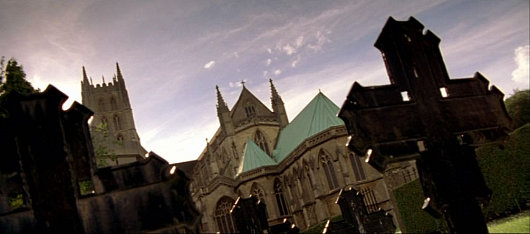
One of Britain’s most prominent Catholic schools, Downside Abbey in Somerset, has a friendship with Freemasonry that Catholics might find rather troubling. As recently brought to light in a report on the Curated Secrets blog, Downside invited “Spenny” Compton, 7th Marquess of Northampton (as well as Britain’s wealthiest Buddhist and sometime Pro-Grand Master of the United Grand Lodge of England) to talk about Freemasonry to students at the Benedictine boarding school. “I was invited two years ago to address some of the senior boys and monks at Downside, the Roman Catholic boarding school,” the Marquess wrote in 2005. (more…)
Altered States in the WSJ
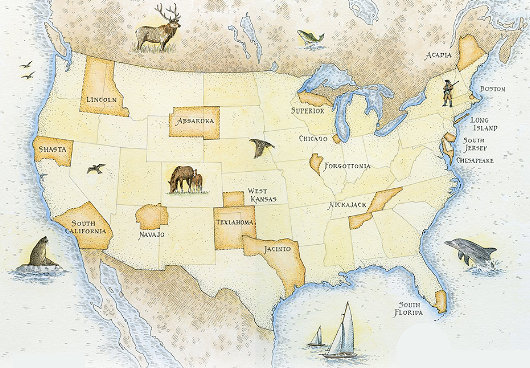
Here’s one for Strange Maps. An interesting article in today’s Wall Street Journal, the Saturday edition, focuses on attempts to realign state borders by seceding from one to state to form another or by merging parts of multiple states to form a new entity. There are two errors, one by the author, Michael J. Trinklein, and one by the illustrator, John Burgoyne. (more…)
Engelsman se Graf
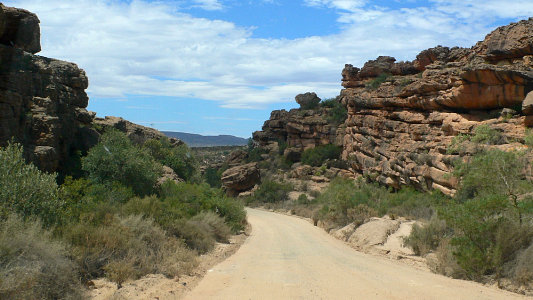
It was just a dot and a name on the map on our way to Wupperthal — Englishman’s Grave, “Hmmm… I wonder what that could be”. The Cederberg mountains have many charms, and of course any one who drinks as much rooibos tea as I must be intrigued to see the only place in the world where it is commercially grown. Leopards, caracals, and bonteboks guard these hills, and of course our friend the dassie (previously seen here) is known to wander around its rocks. (more…)
The Clootie Dumpling
 IT IS A DESIGN masterstroke, combining simplicity and ease of recognition with layers of symbolism. The emblem of the Scottish National Party is just one single line that descends, turns around, and crosses itself, but while remaining uncomplicated manages to evoke the Saltire (Scotland’s flag), the thistle (Scotland’s flower), and — the pudding which has given the logo its nickname — the clootie dumpling, a Scots specialty. And yet, despite its ubiquity, there is surprisingly little to be found online about the history of the SNP’s clootie dumpling.
IT IS A DESIGN masterstroke, combining simplicity and ease of recognition with layers of symbolism. The emblem of the Scottish National Party is just one single line that descends, turns around, and crosses itself, but while remaining uncomplicated manages to evoke the Saltire (Scotland’s flag), the thistle (Scotland’s flower), and — the pudding which has given the logo its nickname — the clootie dumpling, a Scots specialty. And yet, despite its ubiquity, there is surprisingly little to be found online about the history of the SNP’s clootie dumpling.
The emblem was commissioned by William Wolfe (right) in 1962 for the parliamentary by-election in which he was standing as the Scottish Nationalist candidate. The party had typically employed a lion rampant as its symbol, which Wolfe thought too complex, and got Julian Gibb (in his own words, “scarcely out of childhood”) to design the brilliantly simple logo. “A political visionary with an eye for iconography,” according to Gibb, Wolfe used the emblem in the unsuccessful by-election campaign and a year later successfully proposed it to the party for adoption as the party emblem.
“The adoption of a geometric logotype is a bold act for a political organisation, especially a nationalist one, with the swastika a not too distant memory,” writes Gibb. “But the inner logic of the thing was persuasive. Forbye imagined allusions to saltire, thistle, and clootie dumpling, there was perhaps something irresistible about virile angularity supported on swelling curvature, implying among other things that in this outfit, the mechanistic depended on the organic. At one end of the scale of application it was devised to be hastily slapped on walls with a furtively loaded brush (the aerosol age had yet to come) and a quick flick of the wrist – no skill required. Try doing that with the lion rampant.” (more…)
“There is no Generation Benedict”
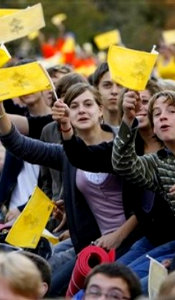 So claims Germany’s Catholic youth leader Dirk Tänzler, who is ‘reserved’ & ‘ambivalent’ about the Pope. Is Tänzler right?
So claims Germany’s Catholic youth leader Dirk Tänzler, who is ‘reserved’ & ‘ambivalent’ about the Pope. Is Tänzler right?
AMIDST THE MEDIA’S attempts to sling mud at Pope Benedict XVI, one of the most prominent Catholic youth leaders in Germany has chimed in with lackluster words about the reigning pontiff. Dirk Tänzler, the head of the BDKJ, the umbrella group of German Catholic youth organizations, gave an interview to Der Spiegel, the prominent weekly news magazine with a circulation of over one million. Asked his verdict of the so-far five years of Pope Benedict’s reign, Tänzler responded with the word “ambivalent”. Contrasting Benedict XVI with John Paul II — a “showmaster” — the BDKJ head said that, despite some good points, “a lot of young people often simply don’t understand him”. “Most have a different idea of how to live their lives than the pope might imagine for them. There is no ‘Generation Benedict.'”
But are Tänzler’s thoughts an accurate reflection of the state of Catholic youth in Germany or elsewhere? Over a million young people travelled to Cologne to experience World Youth Day with the new pontiff in 2005. (The following WYD held in Sydney in 2008, unfortunately offers little comparison given the relative isolation of Australia). Everywhere the Pope has travelled, such as to the Czech Republic last year, or France and the United States in 2008, vast multitudes of youth have greeted him, often waiting hours for the privilege. (more…)
Christen Købke in London
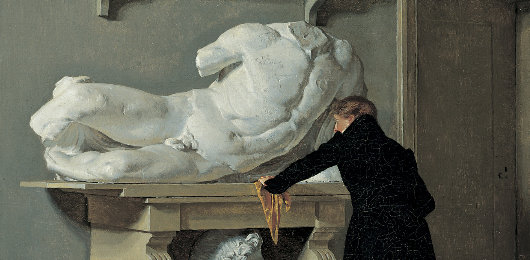
THROUGH JUNE 13, the National Gallery in London is exhibiting “Christen Købke: Danish Master of Light”, a small show of the neglected Danish Golden Age painter but the first exhibition exclusively of his works outside of Denmark. “Kobke generally chooses the quietest corner, or a view from the side,” writes Waldemar Januszczak in The Times. “What fascinates him is the way light falls on the old stones, or the tufts of grass growing between the cracks. Throughout his art, whether he is painting landscapes or people, Købke seems always to be noticing the decay of the world he grew up in.” Januszczak suggests that the warmth of Købke’s work is in reaction to the turbulence of his country’s position in Europe at the time — Denmark backed the wrong horse in the Napoleonic wars and turned to neutrality, only to face a pre-emptive attack by the British in which Copenhagen was ferociously bombarded. The painter was born three years after this humiliation, and at age 12 began his studies at the Royal Danish Academy, where he studied under Christoffer Wilhelm Eckersberg, the ‘Father of Danish painting’.
The talented Købke painted portraits, landscapes, and other scenes. The show at the National Gallery includes my favourite Købke portrait, that of his friend and fellow artist, the landscape painter Frederik Hansen Sødring, on loan from Copenhagen’s Hirschsprung Collection.
His capability aside, what I like about Købke is that he is a certifiable local boy, rarely straying from the vicinity of his native Copenhagen except for the period of study in Italy required of the academically trained artist. His portraits are of his family and his friends, his landscapes of nearby rustic lanes and royal castles. A shame he died of pneumonia just 37 years old.
I haven’t had the chance to view any of his works in the flesh, but Londoners might want to avail themselves of this rare chance to see most of Købke’s capable work while on show in the metropolis. (more…)
Search
Instagram: @andcusack
Click here for my Instagram photos.Most Recent Posts
- Burns Tower April 19, 2024
- Patrick in Parliament March 18, 2024
- Articles of Note: 13 March 2024 March 13, 2024
- Cambridge March 9, 2024
- Taken on Trust March 4, 2024
Most Recent Comments
Book Wishlist
Monthly Archives
Categories


